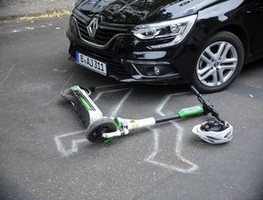KANBrief 2/20

Electric kick scooters have become a common sight in many cities. Anyone who has tried riding such a vehicle will confirm the difficulty of negotiating uneven surfaces on the scooter’s small wheels, or signalling turns by hand. Electric kick scooters are also often ridden by two riders or on the pavement, despite this being prohibited. Further discussion is therefore needed of the safety of these vehicles in traffic.
Since the German Ordinance on the use of personal light electric vehicles (PLEVs) on public roads (eKFV) came into force on 15 June 2019, it has been legally permissible in Germany for persons aged 14 and over to ride electric scooters with handlebars on public roads. Insurance and type approval are mandatory in Germany for these motor vehicles.
Furthermore, electric kick scooters fall within the scope of the EU Machinery Directive. The European standard prEN 17128 (Non-type approved light motorized vehicles for the transportation of persons and goods and related facilities – Personal light electric vehicles (PLEV) – Safety requirements and test methods) currently under development and intended for harmonization will support the directive's safety objectives with respect to electric kick scooters and other light electric vehicles.
Within a few weeks of electric kick scooters being allowed onto German roads, the police had already recorded numerous accidents and violations of the traffic regulations. Hospitals also reported serious head injuries and bone fractures caused by accidents involving these scooters. Many people are not aware that in Germany, riders of electric kick scooters are subject to the same blood alcohol limits as car drivers.
Accidents are caused not only by violations of the regulations, but also by the physics of the moving vehicle: owing to their small wheel diameter, electric kick scooters are much harder to control than bicycles in bends or when ridden over uneven surfaces. Their slim silhouette and rapid acceleration also increase the likelihood of their not being seen.
Were the scooters to be equipped with direction indicators (as yet, not mandatory), riders would no longer have to signal changes in direction by hand and could keep both hands firmly on the handlebars at all times. Germany’s Federal Highway Research Institute (BASt) (Berichte der BASt F 125, 2018, pp. 25f. pdf, in German) has therefore recommended that personal light electric vehicles that are ridden standing should be fitted with indicators. Section 5 (4) of the draft version of the eKFV (pdf, in German) also made provision for mandatory fitting of direction indicators to single-track vehicles.
The design of urban infrastructure is also relevant to safety: as a rule, electric kick scooters are expected to share the traffic space used by bicycles. This further exacerbates competition for the limited road space and bicycle route infrastructure. Electric kick scooters ridden on the pavement in contravention of the regulations present a hazard to pedestrians. Scooters that have been parked carelessly or have fallen over may also constitute a dangerous tripping hazard.
Employees using an electric kick scooter to commute to or from work or for journeys during work are insured by the German Social Accident Insurance (DGUV). Where these vehicles are used as a means of transport on a company’s premises, they are subject to the German Ordinance on industrial safety and health (BetrSichV) and the accident prevention regulation for vehicles (DGUV Regulation 705). Employers must therefore take use of the scooters into account in the risk assessment; they can also lay down safety measures in a procedure, over and above the requirements of the eKFV. Examples of such measures are the requirement for a helmet, retroreflective clothing or suitable footwear to be worn. In addition, companies must provide their employees with theoretical and practical instruction in operation of the vehicle, and the serviceability of the scooters must be checked regularly.
Since January 2020, accidents in Germany involving electric kick scooters have been recorded in a dedicated category within the accident statistics. The BASt has also invited tenders for a scientific evaluation study (pdf, in German), which is to examine the behaviour of electric kick scooter users in road traffic and the impacts of the eKFV on road safety in more detail. The final report is to be available in the fourth quarter of 2022.
Section 15 (4) of the eKFV makes provision for it to be revised in consideration of the results of this evaluation. Should amendment be required, the German Federal Ministry of Transport and Digital Infrastructure would then have until 1 September 2023 to submit a corresponding proposal. In the view of the German Road Safety Council, the core benchmark here should be whether the impacts of the ordinance are consistent with the Vision Zero, i.e. with the goal of reducing the number of persons seriously injured or killed in road traffic to zero.
Tanja Hohenstein